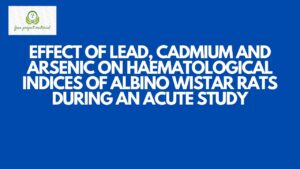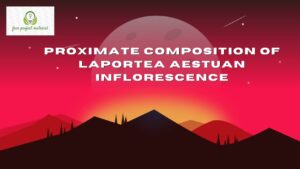ABSTRACT
This study was aimed at determining the magnesium and phosphorus composition of snail shell. Standard analytical methods were employed in carryout the analysis. The result of the study revealed the following concentrations for magnesium; sample A (18.215 mg/100g), sample B (22.441 mg/100g), Sample C (35.892 mg/100g), sample D (11.810 mg/100g). while the concentration of phosphorus in the samples were as follows; sample A (9.552 mg/100g), sample B (6.715 mg/100g), sample C (11.159 mg/100g) and sample D (8.425 mg/100g). This study shows that snail shell are rich source of magnesium and phosphorus. This study also revealed that the concentration of magnesium and phosphorus in the snail shell decreases continually after the shell has been separated from the flesh. Therefore, it is recommended that the snail shell used for enrichments of the soil or as poultry feed should be gotten as soon as the flesh is been extracted.
TABLE OF CONTENTS
Title Page – – – – – – – – i
Certification – – – – – – – ii
Dedication – – – – – – – – iii
Acknowledgements – – – – – – – iv
Abstract – – – – – – – – v
Table of Contents – – – – – – – vi
CHAPTER ONE: INTRODUCTION
1.1 Background of the Study – – – – – – 1
1.2 Aim and Objectives of the study – – – – 4
1.3 Scope and Limitation of the Study – – – – 4
1.4 Definition of Related terms – – – – – 4
CHAPTER TWO
2.1 Description of Snail Classification – – – – 6
2.2 Feeding Habitat of Snail – – – – – – 7
2.3 Morphology, Habitat and Species of Snails – – – 8
2.4 Uses of Snail – – – – – – – 10
2.4.1 In Agriculture – – – – – – – 10
2.4.2 As Food – – – – – – – – 11
2.5 Uses of Snail Shell – – – – – – 12
2.5.1 Waste Water treatment – – – – – – 12
2.5.2 Purification of Aqueous Solution – – – – 14
2.5.3 Enhancing the Strength of Concrete – – – – 15
2.5.4 In medicine and Biomaterials – – – – – 16
2.5.5 As a Reinforcing phase – – – – – – 17
2.6 Mineral element – – – – – – – 19
2.6.1 Magnesium – – – – – – – – 19
2.6.2 Phosphorus – – – – – – – – 21
CHAPTER THREE: MATERIALS AND METHODS
3.1 Materials and Reagents – – – – – – 25
3.2 Methods – – – – – – – – 25
3.2.1 Sample Collection and Preparation – – – – 25
3.2.2 Sample Digestion – – – – – – – 25
3.2.3 Determination of Magnesium and Phosphorus – – 26
CHAPTER FOUR: RESULT AND DISCUSSION
4.1 Results – – – – – – – – 28
4.2 Discussion – – – – – – – – 29
CHAPTER FIVE: CONCLUSION AND RECOMMENDATION
5.1 Conclusion – – – – – – – – 32
5.2 Recommendations – – – – – – – 32
References
CHAPTER ONE
INTRODUCTION
1.1 Background of the Study
Over the centuries, shelled organisms have been of interest to mankind. Their edible portions have always been a source of food (Ravichandran et al., 2009). Some of the species that fall into this category include periwinkles (Tympanotonus fuscatus) found in Europe and Africa, queen conchs (Strombusgigas) in the West Indies, abalones (Haliotis) in California and Japan, turban shells (Turbo) in the pacific and land snails of the family Helicidea which have been eaten since pre-historic times. Those of the reptilia phylum have equally provided humans with meat and eggs (Bunje, 2003; Kozloff, 1990).
Shells of many types were popular for their usage in human decorations. These were either used as a whole or cut into pieces. They were used for all kinds of pendants, beads, buttons, brooches, rings, and hair combs. Small pieces of coloured and iridescent shell have been used to create mosaics and inlays used to decorate larger items such as boxes and furniture (Gemma et al., 2003). A large number of whole seashells, arranged to form patterns, have been used to decorate man-made grottos.
In spite of all these importance, it has been observed that, shells of these organisms are commonly discarded indiscriminately after consumption of the edible portions. This no doubt creates waste disposal and environmental problems (Butterfield, 2003). Sometimes, most of these shells are buried or burnt and only a few are used for decorative, fillers and cleansing purposes.
The snail belongs to the phylum mollusk and class Gastropods. The gastropods are the largest class of the phylum mollusk (Burnt et al., 1999).
Snails live among wet vegetation in damp and shady places, they are more abundant in rainy seasons and most active at night. The snail’s soft body consists of a head, a foot, and a visceral mass or lump, which remains permanently inside a hard protective shell.
They are found predominately in West Africa. All gastropods at some time in their phylogeny and at some stage in their development have undergone torsion. The process does not occur in any other mollusk. It implies that the visceral mass and the mantle shell covering it have become twisted through 180oC in relation to the head and foot. As a result of torsion, all internal organs are twisted into a loop (Aboua, 1995).
More than half of all mollusk species are gastropods and encompass a range from marine, zygo branch, which can be numbered among the most primitive of all living mollusks, to the highly evolved terrestrial air breathing slugs and snails.
The shell of the large land snail is brownish yellow in colour with dark markings and is up to 10cm or more in length, it is very hard snail shell has several important uses, which results from the hard nature of the shell. The shell protects the snail from physical damage predators and dehydration. They are use also in the manufacture of buttons, jewels, and art collection. Recent development involves its application in the treatment of water and waste water resulting from its chemical composition. This composition includes;
Proteins, Carbohydrates, Fats, and Minerals such as Iron, Zinc, Copper etc (Bokin and Edward, 1988).
1.2 Aim and Objectives of the Study
1.2.1 Aim
The aim of this study was to determine the magnesium and phosphorus composition of snail shell.
1.2.2 Objectives
The objectives of this study are;
- To determine the magnesium and phosphorus composition of snail shell that has been disposed at various time
- To compare the magnesium and phosphorus content of the snails shells
- To Compare the result of this study with previous work
- To make recommendations base on the findings of this study
1.3 Scope and Limitation of the Study
This study deals with the determination of the magnesium and phosphorus content of snail shells, this study is limited due to time and financial constraints.
1.4 Definition of Relation Terms
Minerals: Mineral is a chemical element required as an essential nutrient by organisms to perform functions necessary for life.
Snail Shell: The snail shell is part of the body of a gastropod or snail. The shell is an eco skeleton which protects from predators, mechanical damage, and dehydration, but also serve for muscle attachment and calcium storage.
Snail: A snail is a shelled gastropod. The name is most often applied to land snails terrestrial pulmonate gastropod mulluscs.

